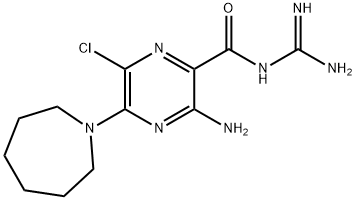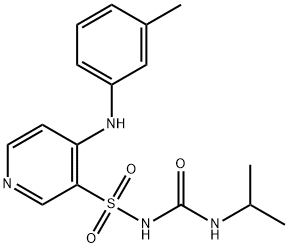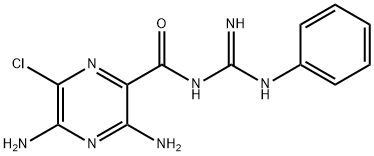Hexamethyleneamiloride , 98% , 1428-95-1
Synonym(s):
HMA
| Pack Size | Price | Stock | Quantity |
| 5mg | RMB693.60 | In Stock |
|
| 10mg | RMB1053.60 | In Stock |
|
| 25mg | RMB1877.60 | In Stock |
|
| others | Enquire |
PRODUCT Properties
| Melting point: | 224-225 °C |
| Density | 1.63±0.1 g/cm3(Predicted) |
| storage temp. | 2-8°C |
| solubility | DMF: 3mg/mL; DMSO: 10mg/mL; DMSO:PBS (pH 7.2) (1:4): 0.2mg/mL |
| form | A crystalline solid |
| pka | 8.81±0.46(Predicted) |
| color | Light yellow to yellow |
Description and Uses
5-(N,N-hexamethylene)-Amiloride (HMA) is a derivative of amiloride with diverse biological activities. It is an allosteric antagonist of adenosine A2A receptors (Ki = 3.3 μM). HMA inhibits the cation-selective ion channel formed by the HIV-1 viral protein Vpu when used at a concentration of 50 μM, as well as budding of virus-like particles in HeLa cells expressing the HIV-1 proteins Gag and Vpu when used at a concentration of 10 μM. It also blocks the cation-selective ion channels formed by the hepatitis C virus (HCV) protein p7. HMA (40 μM) induces necrosis in and reduces the viability of MCF-7, MDA-MB-231, T47D, SK-BR-3, Met-1, and NDL breast cancer cells but not cardiomyocytes or uterine, pulmonary, and renal epithelial cells. HMA protects against post-ischemic contractile dysfunction and reduces coronary effluent creatine phosphokinase activity in a model of ischemia-reperfusion injury using isolated rat right ventricular free walls.
5-(N,N-Hexamethylene)-amiloride (Hexamethylene amiloride) derives from an amiloride and is a potent Na+/H+ exchanger inhibitor, which decreases the intracellular pH (pHi) and induces apoptosis in leukemic cells. 5-(N,N-Hexamethylene)-amiloride (Hexamethylene amiloride) is also an inhibitor of the HIV-1 Vpu virus ion channel and inhibits mouse hepatitis virus (MHV) replication and human coronavirus 229E (HCoV229E) replication in cultured L929 cells with EC50s of 3.91 μM and 1.34 μM, respectively[1][2].
Safety
| Symbol(GHS) |  GHS06 |
| Signal word | Danger |
| Hazard statements | H301+H311+H331 |
| Precautionary statements | P261-P264-P280-P301+P310-P302+P352+P312-P304+P340+P311 |
| Hazard Codes | T |
| Risk Statements | 23/24/25 |
| Safety Statements | 22-36/37/39-45 |
| RIDADR | 2811 |
| WGK Germany | 3 |
| HazardClass | 6.1(b) |
| PackingGroup | III |





